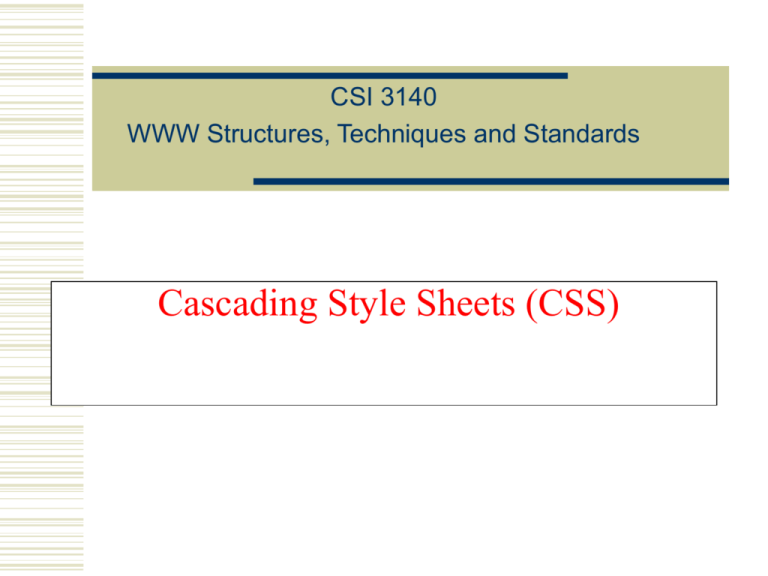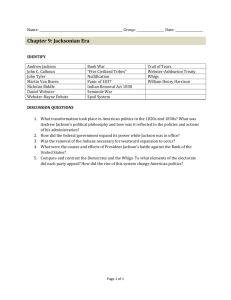Cascading Style Sheets (CSS)
advertisement

CSI 3140
WWW Structures, Techniques and Standards
Cascading Style Sheets (CSS)
Motivation
HTML markup can be used to represent
Semantics: h1 means that an element is a top-level
heading
Presentation: h1 elements look a certain way
It’s advisable to separate semantics from
presentation because:
It’s easier to present documents on multiple platforms
(browser, cell phone, spoken, …)
It’s easier to generate documents with consistent look
Semantic and presentation changes can be made
independently of one another (division of labor)
User control of presentation is facilitated
Guy-Vincent Jourdan :: CSI 3140 :: based on Jeffrey C. Jackson’s slides
Style Sheet Languages
Cascading Style Sheets (CSS)
Applies to (X)HTML as well as XML documents
in general
Focus of this chapter
Extensible Stylesheet Language (XSL)
Often used to transform one XML document to
another form, but can also add style
XSL Transformations covered in later chapter
Guy-Vincent Jourdan :: CSI 3140 :: based on Jeffrey C. Jackson’s slides
CSS Introduction
A styled HTML document
produced by the style sheet style1.css:
Guy-Vincent Jourdan :: CSI 3140 :: based on Jeffrey C. Jackson’s slides
CSS Introduction
link element associates style sheet with doc.
Guy-Vincent Jourdan :: CSI 3140 :: based on Jeffrey C. Jackson’s slides
CSS Introduction
type attribute specifies style language used
Guy-Vincent Jourdan :: CSI 3140 :: based on Jeffrey C. Jackson’s slides
CSS Introduction
href attribute provides style sheet URL
Guy-Vincent Jourdan :: CSI 3140 :: based on Jeffrey C. Jackson’s slides
CSS Introduction
title attribute provides style sheet name
Guy-Vincent Jourdan :: CSI 3140 :: based on Jeffrey C. Jackson’s slides
CSS Introduction
Alternative, user selectable style sheets
can be specified
Guy-Vincent Jourdan :: CSI 3140 :: based on Jeffrey C. Jackson’s slides
CSS Introduction
Guy-Vincent Jourdan :: CSI 3140 :: based on Jeffrey C. Jackson’s slides
CSS Introduction
A styled HTML document
produced by the style sheet style2.css:
Guy-Vincent Jourdan :: CSI 3140 :: based on Jeffrey C. Jackson’s slides
CSS Introduction
Note that alternate, user selectable style is
not widely supported: firefox 3 and IE 8 do,
but IE 6, IE 7 and Chrome don’t.
Guy-Vincent Jourdan :: CSI 3140 :: based on Jeffrey C. Jackson’s slides
CSS Introduction
Single document can be displayed on
multiple media platforms by tailoring style
sheets:
This document will be printed differently than
it is displayed.
Guy-Vincent Jourdan :: CSI 3140 :: based on Jeffrey C. Jackson’s slides
CSS Syntax
Parts of a style rule (or statement)
Guy-Vincent Jourdan :: CSI 3140 :: based on Jeffrey C. Jackson’s slides
CSS Syntax:
Selector Strings
Single element type:
Multiple element types:
All element types:
Specific elements by id:
Guy-Vincent Jourdan :: CSI 3140 :: based on Jeffrey C. Jackson’s slides
CSS Syntax:
Selector Strings
Guy-Vincent Jourdan :: CSI 3140 :: based on Jeffrey C. Jackson’s slides
CSS Syntax:
Selector Strings
Elements belonging to a style class:
class selector: begins with a period .
Referencing a style class in HTML:
Elements of a certain type and class:
Guy-Vincent Jourdan :: CSI 3140 :: based on Jeffrey C. Jackson’s slides
CSS Syntax:
Selector Strings
Elements belonging to a style class:
Referencing a style class in HTML:
this span belongs to three style classes
Elements of a certain type and class:
Guy-Vincent Jourdan :: CSI 3140 :: based on Jeffrey C. Jackson’s slides
CSS Syntax:
Selector Strings
Elements belonging to a style class:
Referencing a style class in HTML:
Elements of a certain type and class:
this rule applies only to span’s belonging to class special
Guy-Vincent Jourdan :: CSI 3140 :: based on Jeffrey C. Jackson’s slides
CSS Syntax:
Selector Strings
Source anchor elements:
pseudo-classes
Element types that are descendents:
Guy-Vincent Jourdan :: CSI 3140 :: based on Jeffrey C. Jackson’s slides
CSS Syntax:
Selector Strings
Source anchor elements:
Element types that are descendants:
rule applies to li element that is
Guy-Vincent Jourdan :: CSI 3140 :: based on Jeffrey C. Jackson’s slides
CSS Syntax:
Selector Strings
Source anchor elements:
Element types that are descendants:
rule applies to li element that is
part of the content of an ol element
Guy-Vincent Jourdan :: CSI 3140 :: based on Jeffrey C. Jackson’s slides
CSS Syntax:
Selector Strings
Source anchor elements:
Element types that are descendants:
rule applies to li element that is
part of the content of an ol element
that is part of the content of a ul element
Guy-Vincent Jourdan :: CSI 3140 :: based on Jeffrey C. Jackson’s slides
CSS Syntax
Style rules covered thus far follow ruleset
syntax
At-rule is a second type of rule
URL relative to style sheet URL
Reads style rules from specified URL
Must appear at beginning of style sheet
Guy-Vincent Jourdan :: CSI 3140 :: based on Jeffrey C. Jackson’s slides
Style Sheets and HTML
Style sheets referenced by link HTML
element are called external style sheets
Style sheets can be embedded directly in
HTML document using style element
Most HTML elements have style attribute
(value Guy-Vincent
is list Jourdan
of style
declarations)
:: CSI 3140 :: based on Jeffrey C. Jackson’s slides
Style Sheets and HTML
Rules of thumb:
Use external style sheets to define site-wide style
Prefer style sheets (either external or embedded)
to style attributes
XML special characters
Must use references in embedded style sheets and
style attribute
Must not use references in external style sheets
Guy-Vincent Jourdan :: CSI 3140 :: based on Jeffrey C. Jackson’s slides
CSS Rule Cascade
What if more than one style declaration
applies to a property of an element?
The CSS rule cascade determines which style
rule’s declaration applies
Guy-Vincent Jourdan :: CSI 3140 :: based on Jeffrey C. Jackson’s slides
CSS Rule Cascade
To find the value for an element/property
combination, user agents must apply the
following sorting order:
1- Find all declarations that apply to the
element and property in question, for the target
media type. Declarations apply if the
associated selector matches the element in
question.
Guy-Vincent Jourdan :: CSI 3140 :: based on Jeffrey C. Jackson’s slides
CSS Rule Cascade
2- The primary sort of the declarations is
by weight and origin: for normal
declarations, author style sheets override
user style sheets which override the default
style sheet. For "!important" declarations,
user style sheets override author style sheets
which override the default style sheet.
"!important" declaration override normal
declarations. An imported style sheet has the
same origin as the style sheet that imported
it.
Five origin/weight levels:
1. user/important
2. author/important
3. author/normal
4. user/normal
5. user agent/normal
Guy-Vincent Jourdan :: CSI 3140 :: based on Jeffrey C. Jackson’s slides
CSS Rule Cascade
3- The secondary sort is by specificity of selector: more
specific selectors will override more general ones. Pseudoelements and pseudo-classes are counted as normal elements
and classes, respectively.
Specificity:
1. style attribute
2. rule with selector:
1. ID
2. class/pseudo-class
3. descendant/element type
4. universal
3. HTML attribute
Guy-Vincent Jourdan :: CSI 3140 :: based on Jeffrey C. Jackson’s slides
CSS Rule Cascade
4- Finally, sort by order specified: if two rules have the same
weight, origin and specificity, the latter specified wins. Rules
in imported style sheets are considered to be before any rules
in the style sheet itself.
Conceptually, create one
long style sheet. Later
style rules have higher
priority than earlier rules.
Guy-Vincent Jourdan :: CSI 3140 :: based on Jeffrey C. Jackson’s slides
CSS Inheritance
What if no style declaration applies to a
property of an element?
Generally, the property value is inherited
from the nearest ancestor element that has a
value for the property
If no ancestor has a value (or the property
does not inherit) then CSS defines an initial
value that is used
Guy-Vincent Jourdan :: CSI 3140 :: based on Jeffrey C. Jackson’s slides
CSS Inheritance
Guy-Vincent Jourdan :: CSI 3140 :: based on Jeffrey C. Jackson’s slides
CSS Inheritance
Property values:
Specified: value contained in declaration
Absolute: value can be determined without reference
to context (e.g., 2cm)
Relative: value depends on context (e.g., larger)
Computed: absolute representation of relative
value (e.g., larger might be 1.2 x parent font
size)
Actual: value actually used by browser (e.g.,
computed value might be rounded)
Guy-Vincent Jourdan :: CSI 3140 :: based on Jeffrey C. Jackson’s slides
CSS Inheritance
Most properties inherit computed value
Exception discussed later: line-height
A little thought can usually tell you whether
a property inherits or not
Example: height does not inherit
Guy-Vincent Jourdan :: CSI 3140 :: based on Jeffrey C. Jackson’s slides
CSS Font Properties
A font is a mapping from code points to glyphs
Glyph (visual representation)
character cell
(content area)
Guy-Vincent Jourdan :: CSI 3140 :: based on Jeffrey C. Jackson’s slides
CSS Font Properties
A font is a mapping from code points to glyphs
glyphs do not necessary stay inside cells!
Guy-Vincent Jourdan :: CSI 3140 :: based on Jeffrey C. Jackson’s slides
CSS Font Properties
A font family is a collection of related fonts
(typically differ in size, weight, etc.)
font-family property can accept a list of
families, including generic font families
first choice font
Guy-Vincent Jourdan :: CSI 3140 :: based on Jeffrey C. Jackson’s slides
CSS Font Properties
A font family is a collection of related fonts
(typically differ in size, weight, etc.)
font-family property can accept a list of
families, including generic font families
second choice font
Guy-Vincent Jourdan :: CSI 3140 :: based on Jeffrey C. Jackson’s slides
CSS Font Properties
A font family is a collection of related fonts
(typically differ in size, weight, etc.)
font-family property can accept a list of
families, including generic font families
generic
Guy-Vincent Jourdan :: CSI 3140 :: based on Jeffrey C. Jackson’s slides
CSS Font Properties
generic
fonts are
systemspecific
Guy-Vincent Jourdan :: CSI 3140 :: based on Jeffrey C. Jackson’s slides
CSS Font Properties
Note that most generic font can be easily set
on Firefox and Chrome, but such option
doesn’t seem to be available on IE 7 and 8. IE
will still default to something although maybe
not what you had hoped for!
Guy-Vincent Jourdan :: CSI 3140 :: based on Jeffrey C. Jackson’s slides
CSS Font Properties
Many properties, such as font-size, have a value that is
a CSS length
All CSS length values except 0 need units
Guy-Vincent Jourdan :: CSI 3140 :: based on Jeffrey C. Jackson’s slides
CSS Font Properties
Computed value
of font-size
property
Guy-Vincent Jourdan :: CSI 3140 :: based on Jeffrey C. Jackson’s slides
CSS Font Properties
Reference font defines em and ex units
Normally, reference font is the font of the
element being styled
Exception: Using em/ex to specify value for
font-size
parent element’s font is
reference font
Guy-Vincent Jourdan :: CSI 3140 :: based on Jeffrey C. Jackson’s slides
CSS Font Properties
Other ways to specify value for
font-size:
Percentage (of parent font-size)
Absolute size keyword: xx-small, x-small,
small, medium (initial value), large,
x-large, xx-large
User agent specific; should differ by ~ 20%
Relative size keyword: smaller, larger
Relative to parent element’s font
Guy-Vincent Jourdan :: CSI 3140 :: based on Jeffrey C. Jackson’s slides
CSS Font Properties
Guy-Vincent Jourdan :: CSI 3140 :: based on Jeffrey C. Jackson’s slides
CSS Font Properties
Text is rendered using line boxes
Height of line box given by line-height
Initial value: normal (i.e., cell height; relationship with
em height is font-specific)
Other values (following are equivalent):
Guy-Vincent Jourdan :: CSI 3140 :: based on Jeffrey C. Jackson’s slides
CSS Font Properties
When line-height is greater than cell
height:
Inheritance of line-height:
Specified value if normal or unit-less number
Computed value otherwise
Guy-Vincent Jourdan :: CSI 3140 :: based on Jeffrey C. Jackson’s slides
CSS Font Properties
font shortcut property:
Guy-Vincent Jourdan :: CSI 3140 :: based on Jeffrey C. Jackson’s slides
CSS Font Properties
font shortcut property:
Initial values used if no value specified in font
property list (that is, potentially reset)
Guy-Vincent Jourdan :: CSI 3140 :: based on Jeffrey C. Jackson’s slides
CSS Font Properties
font shortcut property:
specifying line-height (here, twice cell height)
any order
size and family required,
order-dependent
Guy-Vincent Jourdan :: CSI 3140 :: based on Jeffrey C. Jackson’s slides
CSS Text Formatting
Guy-Vincent Jourdan :: CSI 3140 :: based on Jeffrey C. Jackson’s slides
CSS Text Color
Font color specified by color property
Two primary ways of specifying colors:
Color name: black, gray, silver, white, red, lime,
blue, yellow, aqua, fuchsia, maroon, green, navy,
olive, teal, purple, full list at
http://www.w3.org/TR/SVG11/types.html#Color
Keywords
red/green/blue (RGB) values
Guy-Vincent Jourdan :: CSI 3140 :: based on Jeffrey C. Jackson’s slides
CSS Text Color
Guy-Vincent Jourdan :: CSI 3140 :: based on Jeffrey C. Jackson’s slides
CSS Text Color
Guy-Vincent Jourdan :: CSI 3140 :: based on Jeffrey C. Jackson’s slides
CSS Box Model
Every rendered element occupies a box:
(or outer edge)
(or inner edge)
Guy-Vincent Jourdan :: CSI 3140 :: based on Jeffrey C. Jackson’s slides
CSS Box Model
Guy-Vincent Jourdan :: CSI 3140 :: based on Jeffrey C. Jackson’s slides
CSS Box Model
Guy-Vincent Jourdan :: CSI 3140 :: based on Jeffrey C. Jackson’s slides
CSS Box Model
Guy-Vincent Jourdan :: CSI 3140 :: based on Jeffrey C. Jackson’s slides
CSS Box Model
Guy-Vincent Jourdan :: CSI 3140 :: based on Jeffrey C. Jackson’s slides
CSS Box Model
Guy-Vincent Jourdan :: CSI 3140 :: based on Jeffrey C. Jackson’s slides
CSS Box Model
Guy-Vincent Jourdan :: CSI 3140 :: based on Jeffrey C. Jackson’s slides
CSS Box Model
Guy-Vincent Jourdan :: CSI 3140 :: based on Jeffrey C. Jackson’s slides
CSS Box Model
Guy-Vincent Jourdan :: CSI 3140 :: based on Jeffrey C. Jackson’s slides
CSS Box Model
If multiple declarations apply to a property,
the last declaration overrides earlier
specifications
Left border is 30px wide,
inset style, and red
Guy-Vincent Jourdan :: CSI 3140 :: based on Jeffrey C. Jackson’s slides
Backgrounds
background-color
Specifies background color for content, padding,
and border areas
Margin area is always transparent
Not inherited; initial value transparent
background-image
Specifies (using url() function) image that
will be tiled over an element
Guy-Vincent Jourdan :: CSI 3140 :: based on Jeffrey C. Jackson’s slides
Backgrounds
<body style="background-image:url('CucumberFlowerPot.png')">
Guy-Vincent Jourdan :: CSI 3140 :: based on Jeffrey C. Jackson’s slides
Normal Flow Layout
In normal flow processing, each displayed
element has a corresponding box
html element box is called initial containing
block and corresponds to entire document
Boxes of child elements are contained in boxes
of parent
Sibling block elements are laid out one on top of
the other
Sibling inline elements are one after the other
Guy-Vincent Jourdan :: CSI 3140 :: based on Jeffrey C. Jackson’s slides
Normal Flow Layout
(body)
(html)
Guy-Vincent Jourdan :: CSI 3140 :: based on Jeffrey C. Jackson’s slides
Normal Flow Layout
Block
elements
only
Guy-Vincent Jourdan :: CSI 3140 :: based on Jeffrey C. Jackson’s slides
Normal Flow Layout
html
body
div d1
div d2
div d3
div d4
Top edges of
block boxes are
in document order
Guy-Vincent Jourdan :: CSI 3140 :: based on Jeffrey C. Jackson’s slides
Normal Flow Layout
What is a “block element”?
Element with value block specified for its
display property
User agent style sheet (not CSS) specifies default
values; typical block elements include html,
body, p, pre, div, form, ol, ul, dl, hr, h1
through h6
Most other elements except li and table-related
have inline specified for display
Guy-Vincent Jourdan :: CSI 3140 :: based on Jeffrey C. Jackson’s slides
Normal Flow Layout
When blocks stack, adjacent margins are
collapsed to the size of the larger margin
Guy-Vincent Jourdan :: CSI 3140 :: based on Jeffrey C. Jackson’s slides
Normal Flow Layout
Initial value of width property is auto, which for
block boxes means to make the content area as wide
as possible within margin/padding constraints:
Width of block boxes
increases as browser
client area is widened
Guy-Vincent Jourdan :: CSI 3140 :: based on Jeffrey C. Jackson’s slides
Normal Flow Layout
Can also specify CSS length or percentage
(of parent’s content width) for width
property
By default, width of right margin is
adjusted to accommodate a change to
width
Guy-Vincent Jourdan :: CSI 3140 :: based on Jeffrey C. Jackson’s slides
Normal Flow Layout
Can also specify CSS length or percentage
(of parent’s content width) for width
property
Centering can be achieved by setting
both margins to auto
Guy-Vincent Jourdan :: CSI 3140 :: based on Jeffrey C. Jackson’s slides
Normal Flow Layout
Boxes corresponding to character cells and
inline elements are laid out side by side in line
boxes that are stacked one on top of the other
Heights
based on
content
Character cells aligned by baseline
Guy-Vincent Jourdan :: CSI 3140 :: based on Jeffrey C. Jackson’s slides
Normal Flow Layout
Padding/borders/margins affect width but
not height of inline boxes
Guy-Vincent Jourdan :: CSI 3140 :: based on Jeffrey C. Jackson’s slides
Normal Flow Layout
Specify value for vertical-align to position
an inline element within line box:
initial
value of
verticalalign
Guy-Vincent Jourdan :: CSI 3140 :: based on Jeffrey C. Jackson’s slides
Beyond Normal Flow
CSS allows for boxes to be positioned
outside the normal flow:
Relative positioning
span’s shifted backwards relative to normal flow
Guy-Vincent Jourdan :: CSI 3140 :: based on Jeffrey C. Jackson’s slides
Beyond Normal Flow
CSS allows for boxes to be positioned
outside the normal flow:
Float positioning
span taken out of normal
flow and “floated” to the
left of its line box
Guy-Vincent Jourdan :: CSI 3140 :: based on Jeffrey C. Jackson’s slides
Beyond Normal Flow
CSS allows for boxes to be positioned
outside the normal flow:
Absolute positioning
span’s removed from
normal flow and
positioned relative
to another box
Guy-Vincent Jourdan :: CSI 3140 :: based on Jeffrey C. Jackson’s slides
Beyond Normal Flow
Properties used to specify positioning:
position: static (initial value),
relative, or absolute
Element is positioned if this property not static
Properties left, right, top, bottom apply to
positioned elements
Primary values are auto (initial value) or CSS length
float: none, left, or right
Applies to elements with static and relative
positioning only
Guy-Vincent Jourdan :: CSI 3140 :: based on Jeffrey C. Jackson’s slides
Beyond Normal Flow
Relative positioning
Specifying positive value for right property of
relatively positioned box moves it to left
<span style="background-color:red">&nbsp;&nbsp;&nbsp;&nbsp;
</span><span class="right">Red</span>
span
containing
text moves
left
Guy-Vincent Jourdan :: CSI 3140 :: based on Jeffrey C. Jackson’s slides
Beyond Normal Flow
Relative positioning
Specifying negative value for left property
also moves box to left
<span style="background-color:red">&nbsp;&nbsp;&nbsp;&nbsp;
</span><span class="right">Red</span>
same
effect as
before
Guy-Vincent Jourdan :: CSI 3140 :: based on Jeffrey C. Jackson’s slides
Beyond Normal Flow
Float positioning
Specify value for float property
Guy-Vincent Jourdan :: CSI 3140 :: based on Jeffrey C. Jackson’s slides
Beyond Normal Flow
Float positioning
Specify value for float property
Floated element becomes a CSS block
element (e.g., can set height and width)
Guy-Vincent Jourdan :: CSI 3140 :: based on Jeffrey C. Jackson’s slides
Beyond Normal Flow
Absolute positioning
Specify location for corner of box relative to
positioned containing block
p elements are positioned (but don’t move!)
margin area
padding area
containing
block
This second paragraph has a
note.
Guy-Vincent Jourdan :: CSI 3140 :: based on Jeffrey C. Jackson’s slides
Beyond Normal Flow
Absolute positioning
Specify location for edges of box relative to
positioned containing block
Guy-Vincent Jourdan :: CSI 3140 :: based on Jeffrey C. Jackson’s slides
Beyond Normal Flow
Absolute positioning
10em
padding top
edge
padding left
edge
Guy-Vincent Jourdan :: CSI 3140 :: based on Jeffrey C. Jackson’s slides
Beyond Normal Flow
Absolute positioning
8em
Guy-Vincent Jourdan :: CSI 3140 :: based on Jeffrey C. Jackson’s slides
Beyond Normal Flow
Absolutely positioned box does not affect
positioning of other boxes!
Second absolutely
positioned box
obscures first
Guy-Vincent Jourdan :: CSI 3140 :: based on Jeffrey C. Jackson’s slides
CSS Position-Related Properties
z-index: drawing order for overlaid boxes
(largest number drawn last)
Guy-Vincent Jourdan :: CSI 3140 :: based on Jeffrey C. Jackson’s slides
CSS Position-Related Properties
display: value none means that element
and its descendants are not rendered and do
not affect normal flow
visibility: value hidden (initial value
is visible) means that element and its
descendants are not rendered but still do affect
normal flow
Guy-Vincent Jourdan :: CSI 3140 :: based on Jeffrey C. Jackson’s slides







